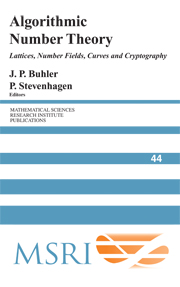Book contents
- Frontmatter
- Contents
- Preface
- Solving the Pell equation
- Basic algorithms in number theory
- Smooth numbers and the quadratic sieve
- The number field sieve
- Four primality testing algorithms
- Lattices
- Elliptic curves
- The arithmetic of number rings
- Smooth numbers: computational number theory and beyond
- Fast multiplication and its applications
- Elementary thoughts on discrete logarithms
- The impact of the number field sieve on the discrete logarithm problem in finite fields
- Reducing lattice bases to find small-height values of univariate polynomials
- Computing Arakelov class groups
- Computational class field theory
- Protecting communications against forgery
- Algorithmic theory of zeta functions over finite fields
- Counting points onvarieties over finite fields of small characteristic
- Congruent number problems and their variants
- An introduction to computing modular forms using modular symbols
Protecting communications against forgery
Published online by Cambridge University Press: 30 May 2025
- Frontmatter
- Contents
- Preface
- Solving the Pell equation
- Basic algorithms in number theory
- Smooth numbers and the quadratic sieve
- The number field sieve
- Four primality testing algorithms
- Lattices
- Elliptic curves
- The arithmetic of number rings
- Smooth numbers: computational number theory and beyond
- Fast multiplication and its applications
- Elementary thoughts on discrete logarithms
- The impact of the number field sieve on the discrete logarithm problem in finite fields
- Reducing lattice bases to find small-height values of univariate polynomials
- Computing Arakelov class groups
- Computational class field theory
- Protecting communications against forgery
- Algorithmic theory of zeta functions over finite fields
- Counting points onvarieties over finite fields of small characteristic
- Congruent number problems and their variants
- An introduction to computing modular forms using modular symbols
Summary
This paper is an introduction to cryptography. It covers secret-key message-authentication codes, unpredictable random functions, public-key secret-sharing systems, and public-key signature systems.
Cryptography protects communications against espionage: an eavesdropper who intercepts a message will be unable to decipher it. This is useful for many types of information: credit-card transactions, medical records, love letters.
Cryptography also protects communications against sabotage: a forger who fabricates or modifies a message will be unable to deceive the receiver. This is useful for alltypes of information. If the receiver does not care about the authenticity of a message, why is he listening to the message in the first place?
This paper explains how cryptography prevents forgery. Section 2 explains how to protect nmessages if the sender and receiver share 128(n + 1)secret bits. Section 3 explains how the sender and receiver can generate many shared secret bits from a short shared secret. Section 4 explains how the sender and receiver can generate a short shared secret from a public conversation. Section 5 explains how the sender can protect a message sent to many receivers, without sharing any secrets.
Information
- Type
- Chapter
- Information
- Algorithmic Number TheoryLattices, Number Fields, Curves and Cryptography, pp. 535 - 550Publisher: Cambridge University PressPrint publication year: 2008
